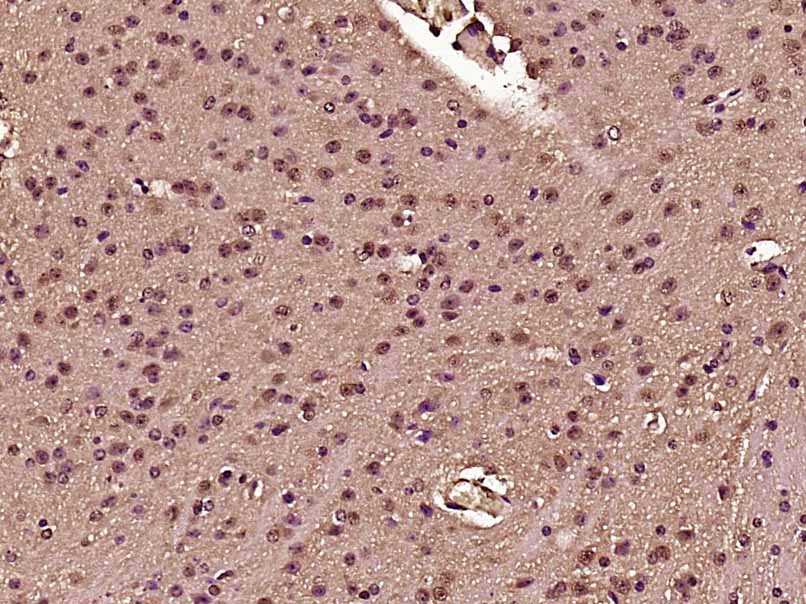
Rabbit Anti-PTBP2 antibody
brPTB; FLJ34897; MIBP; Neural polypyrimidine tract binding protein; Neurally enriched homolog of PTB; Polypyrimidine tract binding protein 2; PTB; PTB like; PTB like protein; PTBLP; PTBP 2; PTBP-2; Splicing regulator; PTBP2_HUMAN.
View History [Clear]
Details
Product Name PTBP2 Chinese Name 核糖核酸Binding protein2抗体 Alias brPTB; FLJ34897; MIBP; Neural polypyrimidine tract binding protein; Neurally enriched homolog of PTB; Polypyrimidine tract binding protein 2; PTB; PTB like; PTB like protein; PTBLP; PTBP 2; PTBP-2; Splicing regulator; PTBP2_HUMAN. Research Area Cell biology Neurobiology Signal transduction Epigenetics Immunogen Species Rabbit Clonality Polyclonal React Species Mouse, (predicted: Human, Rat, Dog, Cow, Horse, Sheep, ) Applications WB=1:500-2000 ELISA=1:5000-10000 IHC-P=1:100-500 IHC-F=1:100-500 ICC=1:100-500 IF=1:100-500 (Paraffin sections need antigen repair)
not yet tested in other applications.
optimal dilutions/concentrations should be determined by the end user.Theoretical molecular weight 57kDa Cellular localization The nucleus Form Liquid Concentration 1mg/ml immunogen KLH conjugated synthetic peptide derived from human PTBP2: 21-120/531 Lsotype IgG Purification affinity purified by Protein A Buffer Solution 0.01M TBS(pH7.4) with 1% BSA, 0.03% Proclin300 and 50% Glycerol. Storage Shipped at 4℃. Store at -20 °C for one year. Avoid repeated freeze/thaw cycles. Attention This product as supplied is intended for research use only, not for use in human, therapeutic or diagnostic applications. PubMed PubMed Product Detail PTBP-2 is a member of the polypyrimidine tract binding family of proteins. Predominantly expressed in brain, but also found in heart and skeletal muscle, PTBP-2 localizes to the nucleus and contains four RRM (RNA recognition motif) domains. PTBP-2 functions as an RNA-binding protein associated in a complex that is involved in the regulation of exon splicing and the stabilization of mRNAs in the cytoplasm. Six isoforms exist for PTBP-2 due to alternative splicing events. Isoforms 1 and 2 (also known as nPTB1 and nPTB2/PTBPLP-L, respectively) are neuronal-specific. Isoforms 3 and 4 (also known as nPTB3/PTBPLP-L and nPTB4, respectively) are found in non-neuronal tissues, as are isoforms 5 and 6 (also known as nPTB5/nPTB7/PTBPLP-S and nPTB6/nPTB8/PTBPLP-S, respectively). The existence of various isoforms may function to modulate the RNA-binding properties of PTBP-2
Function:
PTPBP2 is an RNA-binding protein which binds to intronic polypyrimidine tracts. It binds to the CUCUCU splicing repressor element of the downstream control sequence (DCS) and mediates negative regulation of exons splicing. It may also have a role in the regulation of translation. PTBP2 is thought to be involved in the switch to neuronal specific alternative splicing patterns during neuronal differentiation.
Subunit:
Monomer. Interacts with NOVA1; the interaction is direct. Interacts with NOVA2; the interaction is direct (By similarity). Identified in a mRNP complex, at least composed of DHX9, DDX3X, ELAVL1, HNRNPU, IGF2BP1, ILF3, PABPC1, PCBP2, PTBP2, STAU1, STAU2, SYNCRIP and YBX1. Part of a ternary complex containing KHSRP and HNRPH1.
Subcellular Location:
Nuclear
Tissue Specificity:
Mainly expressed in brain although also detected in other tissues like heart and skeletal muscle. Isoform 1 and isoform 2 are specifically expressed in neuronal tissues. Isoform 3 and isoform 4 are expressed in non-neuronal tissues. Isoform 5 and isoform 6 are truncated forms expressed in non-neuronal tissues.
Similarity:
Contains 4 RRM (RNA recognition motif) domains.
SWISS:
Q9UKA9
Gene ID:
58155
Database links:Entrez Gene: 58155 Human
Entrez Gene: 56195 Mouse
Omim: 608449 Human
SwissProt: Q9UKA9 Human
SwissProt: Q91Z31 Mouse
Unigene: 269895 Human
Unigene: 596061 Human
Unigene: 29966 Mouse
Unigene: 64916 Rat
Product Picture
Partial purchase records(bought amounts latest0)
No one bought this product
User Comment(Total0User Comment Num)
- No comment



 +86 571 56623320
+86 571 56623320




